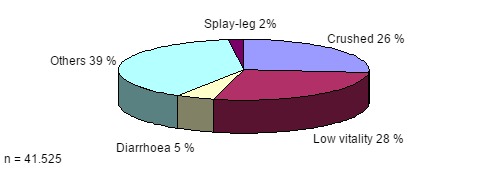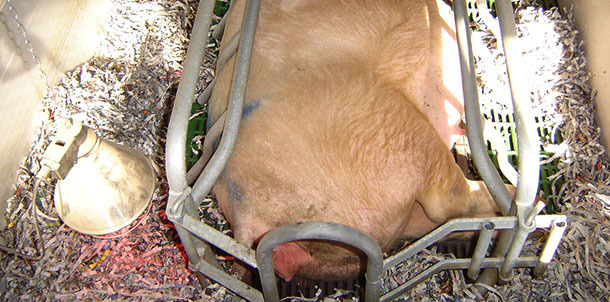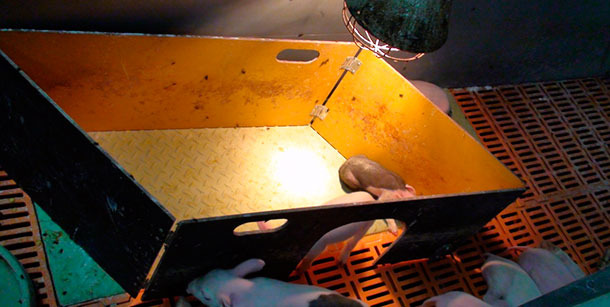Nothing has more impact on piglet survival that an adequate intake of colostrum, which provides energy and immunity.
Between 50-75% of the piglets that die generally do so within the first 72 hours of life.

Variability of colostrum production per sow and intake per piglet is large.
As shown in Table 1, the amount of colostrum ingested by the piglets and mortality are closely linked.
Table 1. Mortality and colostrum intake ratio
| Colostrum intake | Pre-weaning mortality |
| <200 g | 43.4% |
| >200 g | 7.1% |
| Mortality within the first 3 days of life reaches an 82% among piglets that have not ingested sufficient colostrum. | |
| Devillers, Dividich, Prunier, 2007 | |
It is good to know that piglets should take at least 200 g of colostrum, but 300 g to 400 g would be better. Unfortunately, it is not possible to measure the amount of colostrum ingested on farm and, therefore, it can not be established as a target. On the contrary, pre-weaning mortality is indeed easily measurable.
Table 2. Average pre-weaning mortality data.
| Pre-weaning mortality | |
| Average in Spain 2014 (BD Porc) | 12.3% |
| Average in Denmark 2012 (PRC) | 13.6% |
| Best 25% in Denmark 2012 (PRC) | 11.6% |

Figure 1. Distribution of death causes during lactation. 2006 (Pighamp, published in 3tres3).
Crushing can vary from 32% (Holyoate, 1995) to 83% (Koketsu, 2006).
Variations in the causes of death, the time they occur and, probably even more, the way they are recorded, are wide. It is important to implement simple and rigorous data recording systems (Tables 3 and 4) in order to obtain useful information that can be controlled by the person implementing them. Any measure to improve the intake of colostrum should have an effect on pre-weaning mortality. Using a suitable data system should allow us to measure the success or failure of the measure itself.

Table 3. Mortality control in the farrowing rooms
Week #___________ Pre-weaning mortality:
Age (days)
| Cause | 1 | 2 | 3 | 4 | 5-10 | 11-20 | 21+ |
| Crushed | |||||||
| Hunger | |||||||
| Non-viable | |||||||
| Cold | |||||||
| Diarrhoea | |||||||
| Infection | |||||||
| Cannibalism | |||||||
| Castration | |||||||
| Other: (please, specify) |
Sum:
Total deaths per week:
Total born:
Table 4. Mortality control in the farrowing rooms specific for non-viable piglets.
Week #___________ Pre-weaning mortality:
Age (days)
| Cause | 1 | 2 | 3 | 4 | 5-10 | 11-20 | 21+ |
| Crushed | |||||||
| Hunger | |||||||
| Cold | |||||||
| Small <800g | |||||||
| Lack of vitality | |||||||
| Malformations | |||||||
| Diarrhoea | |||||||
| Castration | |||||||
| Cannibalism |
Sum:
Total deaths per week:
Total born:
Colostrum intake, cold, crushed and non-viable are interrelated.
Factors affecting colostrum intake
- Piglet size at birth: Increase of 28 g per 100 g increase in birth weight (Devillers, Farmer, Dividich and Prunier, 2006).
- Piglet vitality.
- Litter size: As opposed to milk, colostrum production does not increase with litter size, so its availability decreases between 22-42 g / day if litter size increases by one piglet (Dividich, 2005).
- Time from birth to first suckling affects colostrum production: 11g less for every minute of delay. (Declerck et al., 2015.)
- Piglets birth order: Some studies suggest birth order has no impact, but other studies did find a link with colostrum intake and others with pre-weaning mortality.
Measures to improve colostrum intake
- Piglets ≤ 1200g average live weight at birth: Supplement the gestating sow feed in U without increasing the total average consumption in the 115 days of gestation.
- Overall thermal control: Colostrum intake hours are special; the piglets require extra heat and the use of the pen space is very different from the rest of the lactation period.

Photo 1. Farrowing pen ready to be used. Photo courtesy of Jordi Ventura.
We must take into account that many farrowings happen at dawn and, therefore, we must consider the temperature fluctuations throughout the day, drafts, humidity, etc.
If your pens have concrete or metal floors, which are much colder than plastic flooring, it may be necessary to install a heating cannon.
- Individual thermal control: A common measure to facilitate colostrum intake for small piglets consists of placing the bigger ones in a box or nest in order to reduce competition. Before that, it is convenient to get the small piglets confined, dry and warm, so that they have enough energy to ingest the colostrum.
We'll have to move them from the pen cold areas to the warm area.

Photo 2. Box that can double as a closed box —with the opening towards the separation—, and an open box
Disturbing the piglets that are sleeping next to the udder during lactation may encourage intake and allows identification of those piglets that are having difficulties. All those piglets that are not eating, at risk of crushing, or which temperature is dropping should be moved to the nest.
Piglets located at the back of the sow on a metal slatted floor will almost certainly die unless we do something. We can clearly see that the piglets marked red need help: heat and less competition for access to the udder. Candidates to be transferred to another sow in order to lower competition in a very large litter can be marked blue.
Management of adoptions
Adoptions to match litters are an important task and must have their specific runtime routine on the farm. If we ask a farmer: When do you carry out the adoptions? His answer will most likely be: "I move the piglets 24 hours after birth."
Yes but, how does that work? This is what really happens: Let's imagine a farm where working hours extend to 7 pm, in which adoptions are carried out at 9 am. If we check in the sow's records the farrowing date and the time point the first piglet is seen (which can be helpful to control the presence or absence of assistance during the farrowings), then we'll notice that the piglets that are moved include those born between 11 pm the previous day (4-hour farrowings) and 7:01 pm the day before, i.e. piglets that have spent 10 hours and piglets that have spent 38 hours with their mother.
For a stricter control, it is convenient to record the date and time farrowings are monitored.
To ensure that the younger piglets we move have taken enough colostrum, we can implement a system to mark the piglets that are born first, have a good size and have been seen taking colostrum. Before ending the day, the piglets marked as "having had colostrum" can be moved from litters with 19 piglets or more. This can help decrease the number of crushed piglets as well as excessive competition.
In order to optimize the use of the udders, we can also leave the weakest piglets in the litter, and move just the strongest ones. In any case, it is advisable to minimize the movement of piglets.
Conclusion
To optimize productivity, it is essential to have an adequate intake of colostrum, and for that to be a reality in a commercial farm, we need to pay close attention to small details that make big differences. Changes need to be studied, implemented and measured, and then we need to start all over again.



